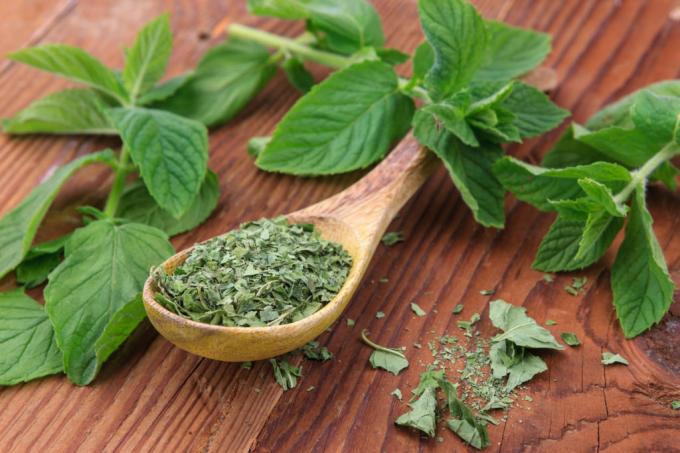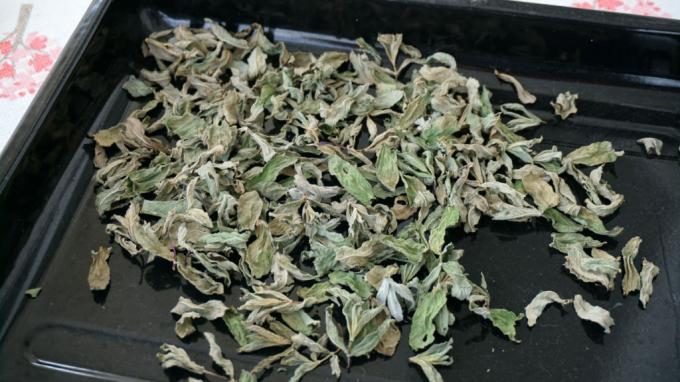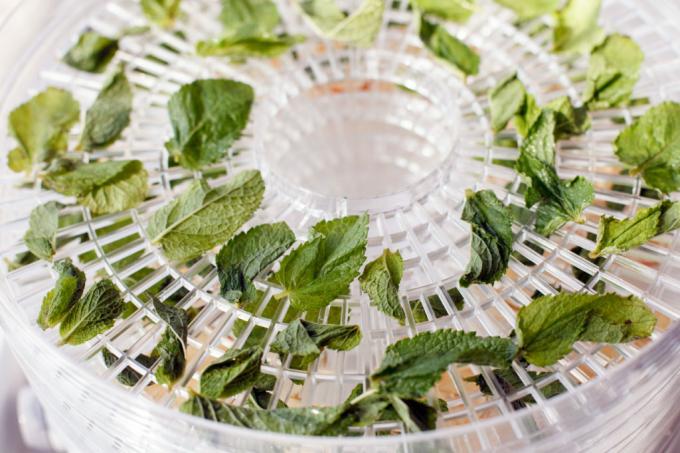Mint gives off its refreshing aroma, especially when dried and as a tea. Find out everything about the right harvest time and how to dry mint in this article.

mint (Mentha) and especially their famous variety, the peppermint (Mentha×piperita), are probably among the most popular herbs in Germany. Its intense, fresh aroma makes the plant a real treat and provides culinary sensations as a tea, in drinks or as a spice. Even the plant is often grown in the garden - No wonder, after all, caring for the mint requires minimal effort, and the herb is considered to be extremely robust and grateful. However, if you want to supply yourself with home-grown mint all year round, you should make provisions in good time. Drying is a great way to preserve the mint and enjoy it in winter too.
contents
- Why should you dry mint?
- Harvesting mint: when and how to do it
- Prepare the mint for drying
-
What's the best way to dry mint?
- Air dry mint
- Dry mint in the oven
- Dry the mint in the dehydrator
- Microwave mint leaves
- Store and keep mint properly
- Dry or freeze mint?
Why should you dry mint?
Fresh mint from your own garden still has the most intense aroma. Unfortunately, the herb only lasts a few days in the refrigerator before it wilts and is no longer usable. Since the mint in the garden and on the balcony can only be harvested until the first frosts in autumn, gardeners have to store their harvest differently in order to be able to enjoy the fresh plant until next spring experience. Drying in particular has been found to be particularly useful in preserving the mint because it keeps it going On the one hand, the aroma and consistency are largely retained; on the other hand, the mint can be kept for several months.
Harvesting mint: when and how to do it
In theory, mint leaves can be harvested from spring to autumn. However, if you expect a particularly intense taste from your mint or peppermint leaves, timing the harvest is essential. In warm weather and sunshine, the plant produces a particularly large number of essential oils. The taste is most intense just before flowering, so that early summer is the perfect time for harvest. But there is also one in autumn Mint harvest Still possible: Before the first frosts, the plants can be harvested again thoroughly to replenish the supply for the winter. The individual shoots should be cut as close to the ground as possible, because the mint sprouts very quickly and well. Of course, individual leaves can also be harvested. However, this is not recommended for collecting larger quantities, such as those commonly used in canning.

Prepare the mint for drying
Before starting to dry the mint, the freshly picked plants must be prepared for the next processing step. To do this, the wheat should first be separated from the chaff: rotten or withered stalks have no place in the food and are therefore carefully sorted out before drying. You can now remove dust and earth from the leaves by shaking them. Water should only be used in exceptional cases when cleaning mint - many of the essential oils of the plant are unfortunately water-soluble, which is why extensive washing has a negative effect on the aroma can. Especially if you want to make mint tea yourself, you should therefore refrain from cleaning with water. However, a wash cycle may be unavoidable in the case of coarser soiling. In order to preserve the aroma, the leaves should only be rinsed with cold water and dried as quickly as possible. At best, this is done gently by dabbing with a kitchen towel.
What's the best way to dry mint?
Drying is believed to be the best method when it comes to preserving mint. A major advantage of the method is that the ingredients and aroma are particularly well preserved during the drying process. The following applies: the gentler the drying, the more intense the aroma. There are now numerous ways to dry mint after harvest. In the following we have summarized for you the advantages of the individual processes and how they work.

Air dry mint
Traditionally, mint is tied in bunches and air-dried. Even if this method appears to many to be out of date and too time-consuming, drying (pepper) mint in the air is definitely recommended. In fact, this air drying is the gentlest of the mint and therefore best preserves the intense aroma of the plant. But before you can start drying, the mint must be tied into small bunches. Now they should be hung upside down in a warm place without direct sunlight - ideally at a temperature of 20 ° C. Depending on the thickness of the bouquet, it takes two to three weeks for the mint to dry completely. The dried mint is best recognized by its stems: if they can be easily broken through, they are dry enough.
Dry mint in the oven
Drying mint and peppermint leaves in the oven is also quick and easy. For this purpose, the leaves are laid out individually on a baking sheet with parchment paper. The oven is meanwhile preheated to around 50 ° C. About five minutes after the mint has moved into the preheated oven, it is switched off. The remaining heat continues to dry the mint leaves. After about 20 minutes, the mint should be completely dry, which can be recognized by the curling of its leaves. As soon as the leaves have dried, they can be removed from the oven - otherwise there is a risk that the mint will become brittle or even burn easily. In contrast to air drying, drying mint in the oven has the great advantage that it hardly takes up any time and, above all, space. However, the aroma is often less intense when drying in the oven, and drying in the oven also consumes additional energy.

Dry the mint in the dehydrator
A dehydrator is ideal for drying mint and other herbs quickly but gently at the same time. In contrast to air drying, this method has the advantage that it is relatively quick and space-saving. In addition, drying in the automatic dehydrator is considered to be particularly gentle because, unlike in the oven, you can Set the temperature here significantly lower and there is sufficient air circulation taken care of. In order for the mint to dry as best as possible in the dehydrator, the leaves are distributed individually and without overlapping on the respective levels of the machine. The mint is now gently dried on the lowest setting. From now on you should check every five minutes whether the mint has already dried sufficiently. As with the oven, this can be seen particularly well by the curled leaves of the mint.
Microwave mint leaves
Dry in seconds - if you don't have a lot of time, you can let your mint dry particularly quickly in the microwave. For this, a handful of the leaves are placed on a microwave-safe plate (if possible without overlapping) and dried on the lowest setting at ten-second intervals. How much the individual leaves have dried in the meantime can be easily checked in the breaks. Overall, this technique only takes a few minutes to preserve small amounts of the herb. However, drying in the microwave has one disadvantage: the rapid warming of the leaves means that much of the fresh aroma of the mint is lost.

Store and keep mint properly
As soon as the mint leaves are completely dry, they can be put into a practical storage option. There are two simple signs that you can tell whether the mint is really dry: On the one hand, it is curling Mint leaves in the dried state, on the other hand, the leaves can be removed from the stem by minimal touch with the finger to solve. If the leaves are still smooth or can only be picked off by tearing them, the mint is not yet dry enough to be stored without spoiling. When storing the dried mint leaves, it is particularly important to ensure that no moisture gets on the dried herb. In fact, the humidity in the room can already cause the mint to spoil more quickly. Airtight packaging is therefore essential in order to store the dried leaves for as long as possible. Glasses with screw caps are best suited for this, but airtight Tupperware containers also offer reliable protection. Those who value a long shelf life and a full-bodied aroma can also vacuum-seal the dried mint in small portions. When properly stored, the dried mint leaves can be kept for several months to a year - however, the taste suffers if the leaves are stored for a longer period of time.
Dry or freeze mint?
Whether one should freeze mint or rather dry it is a question on which opinions differ. In fact, both methods have their advantages and disadvantages. Without a doubt, the aroma is retained better when frozen, which is why this method is particularly suitable for making aromatic drinks or dishes. Mint is particularly popular for this purpose, already chopped up and portioned in one Ice cube trays frozen - this results in a particularly aromatic eye-catcher for cool ones Drinks in summer. However, if you prefer to have whole leaves for garnishing food, you should rely on the drying of the mint: Frozen mint leaves become mushy and unsightly when thawed. Dried peppermint leaves are also often more popular with homemade mint tea. When it comes to shelf life, however, the two methods hardly differ from each other: If stored well, mint can be stored both frozen and dried for up to a year.

What you at Cultivation of mint in your own garden, we'll tell you here.


